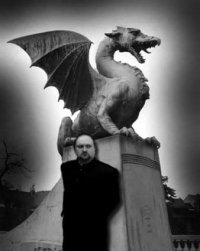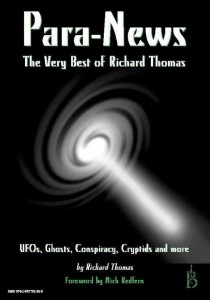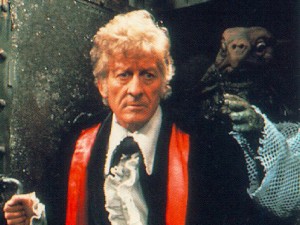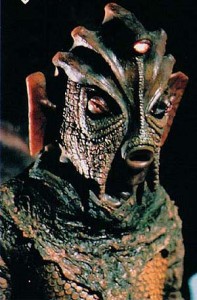Yetis, Dragons, Doctor Who And More!!
Posted by: Richard Thomas on May 29th, 2011

I originally posted this interview with Richard Freeman as a two part interview at Binnall of America back in 2009 (Part I and II). Thought it might be a good idea to repost it here in one place. I have a new ebook out, “PARA-NEWS,” which includes a cryptozoology chapter and where you can read other interviews I’ve done with other researchers, including Neil Arnold and Nick Redfern. You can buy it on Amazon US and Amazon UK.
http://www.amazon.com/gp/product/B0051PR066/ref=ase_cryptomundo08-20/
Richard Thomas: First things first, thank you very much for giving us the time to answer these questions. I really appreciate it and I’m sure our readers will too.
In hindsight, how do you think you first became interested in cryptozoology and other Fortean type subjects? Richard Holland (editor of Paranormal magazine) and Nick Redfern both tell me you’re a “huge” Doctor Who fan, would I be wrong in thinking that, like me, a childhood obsession with the classic series played a big part?
Richard Freeman: Yes, you would be right. I grew up in the Jon Pertwee era and, because he was incarcerated on Earth by the Time Lords, the monsters the third Doctor faced seemed more compelling and real. A monster in your back yard is more frightening than a monster on some alien planet. Doctor Who oozed menace and weirdness in a way no other show has before or since. Giant maggots exploding out of Welsh slag heaps, killer dolls animated by an alien will, super evolved marine dinosaurs, you wouldn’t get stuff like this in Star Trek. This sparked my interest in monsters.
Richard Thomas: I understand you’re the “zoological director” for the Centre for Fortean Zoology (CFZ). What exactly does the CFZ do and how did you become involved with it?
Richard Freeman: The Centre for Fortean Zoology is the only full time scientific organisation dedicated to cryptozoology, the study of unknown species of animal. I came upon a copy of the society’s journal Animals & Men in the now defunct Potter’s Museum of Curiosities in Cornwall. I started to write for them, became the Yokshire rep then, after I finished my zoology degree, I was invited down to work with them on a permanent basis.
Richard Thomas: As a cryptozoologist who has written and lectured widely on the subject, aside from ABCs and the British Bigfoot (which we will discuss later), what are some of the “mystery animals” you are convinced are probably real?
Richard Freeman: The thylacine or Tasmanian wolf, a striped, dog like, flesh eating marsupial. The thylacine was supposedly hunted into extinction in the mid 1930s but there have been over 4000 sightings since then, some by zoologists and park ranger. There have also been a couple of film sequences that I have seen analysed frame by frame. I have no doubt this creature is still around.
The giant anaconda. This snake gives birth to live young rather than laying eggs. Ergo it has severed its last link with land and can spend 99% of its time in water. Thus buoyed up, it can reach huge sizes, perhaps as much as 60 feet!
Orang-pendek, an upright walking ape from Sumatra. Debbie Martyr, head of the Indonesian Tiger Conservation Group has seen it four times. It is probably related to the orangutan but adapted for a bipedal existence on the forest floor. The yeti, possibly a surviving form of the giant ape Gigantopithecus blacki that lived in China and India 500,000 years ago. Hair has been analysed in the UK, USA and China. The results were the same: unknown primate.
The Almasty, a relic hominid, an ultra primitive kind of man, it has no fire and only ape-like tool use. I know two scientists who have seen this creature and I think I came within 12 feet of one last Summer on a derelict farm in Russia at 2.30 am.
Dragons, the original uber monster. Found in every culture and dating back at least 25,000 years in cave paintings. Still seen today in parts of Asian and Africa and the worlds oceans. Possibly the descendant of a group of prehistoric seagoing crocodiles. World wide the dragon is more associated with water than it is with fire.
Richard Thomas: Likewise, are there any of these alleged cryptozoological creatures that you think are just modern day myths or simply a product of peoples’ imaginations? Richard Freeman: Surviving dinosaurs can be explained by other animals. The sauropod reports by an unknown species of giant, semiaquatic monitor lizard in both Africa. The Tyrannosaur like reports in New Guinea and Australia are probably giant monitor lizards rearing up onto their hind legs. The supposed horned dinosaur in Africa is probably a species of rhino.
Richard Thomas: My younger sister actually had an ABC (Alien Big Cat) sighting here in Wales. What are your thoughts on the “big cats” seen in Britain? Do you think they’re simply flesh and blood animals or do you think in some cases something far stranger could be happening?
Richard Freeman: There is no doubt big cats are alive and well in the UK. A female puma was captured in Inverness in 1980. These are descendants of escapees and deliberate releases. Until the Dangerous Wild Animals act anyone could keep anything as a pet and up till the early 1980s an old duffer could start a zoo in their back yard! The nucleus of the current ABC population in the UK was from these irresponsible people.
Richard Thomas: Neil Arnold has written Monster! – The A-Z of Zooform Phenomena, a truly unique book about: “a void of creatures which clearly aren’t flesh and blood, yet which cryptozoology and the paranormal realm attempts to file, and yet … fit into neither.” What are your thoughts on “Zooform” phenomena? Richard Freeman: Zooform phenomena may have something to do with the human mind. There is a global monster template of archetypes that are found all over the world. Dragons, hairy giants, little people, big cats, monster dogs, monster birds. These all have analogues with creatures that would have been preying on or competing with our primitive ancestors on the plains of East Africa three million years ago. Crocodiles, pythons, larger and smaller primate species, leopards and lions, hunting dogs, large raptors like the martial eagle. I think we carry these beasts as fears or fossil memories in our collective subconscious. At certain times they can become externalised and take on a quasi-solid form for a while.
Richard Thomas: Nick Redfern has written a book with the interesting title Man-Monkey: In Search of the British Bigfoot. What do you think the likelihood of such a creature in the UK really is and, perhaps more interestingly, what do think it could be? For instance, do you think we’re dealing with some kind of missing link or something else entirely? Richard Freeman: There is no way a species of giant ape could live undetected in the UK. You would need a population to carry the species on and there is just not enough room. The UK is not like Canada or Tibet, a real ape or hominid would have been discovered decades ago. I think what people are seeing are zooform creatures.
Interestingly though, relic hominids may have lived on mainland Europe until relatively recently. The trolls of Scandinavia sound very like them and as recently as the 1980s a hominid was reported from western Russia only 15 miles from the borders of Finland.
Richard Thomas: The Chupacabra of Latin America is probably the strangest cryptozoological type creature I’ve heard of and think just might actually exist. What are your thoughts on the Chupacabra? Do you think we’re dealing with something extraterrestrial or something much more mundane?
Richard Freeman: My colleague Jon Downes has investigated the Chupacabra in Puerto Rico. He concluded that most of the attacks on livestock were done by imported mongooses as well as feral dogs. He thinks that the spiny backed beast reported from the area is an unknown species of new world porcupine.
Richard Thomas: Have you got any books or anything coming out soon? Maybe a new case or something has grabbed your attention recently?
Richard Freeman: I have two books out currently Dragons: More Than a Myth? from CFZ Press and Explore Dragons from Heart of Albion. Later this year my new book, The Great Yokai Encyclopaedia: an A to Z of Japanese Monsters is out from CFZ Press. I have become enthralled with Japanese folklore. They have the weirdest monsters on Earth including a giant man eating sea cucumber that grows from the knickers of a girl, a giant flesh eating rabbit that digs up human bodies to eat their livers, and a flaming pig that steals hunan genitals. Fortunately most of these are purely imaginary.
Richard Thomas: Thanks again, I’m looking forward to doing part II of this interview with you for my other BoA column Sci-Fi Worlds. There we can go more in-depth about our shared obsession with Doctor Who.
Richard Thomas: You said that Doctor Who, the Jon Pertwee era in particular, played a huge part in you becoming interested in Cryptozoology and other Fortean type subjects. What do you think was your favorite Doctor Who monster growing up and why?
Richard Freeman: I always loved the Sea Devils. They look just great. I love reptiles and have worked extensively with them. I was on the side of the Sea Devils rather than the humans in that story. Dale Russell and Ron Seguin ripped the Sea Devils off in 1982 with their ‘dinosaurid,’ a hypothetical intelligent, humanoid dinosaur they postulated could have evolved from the therapod dinosaur ‘troodon’.
The god awful series V in the 1980s also stole the idea as did the mind bendingly unimaginative Star Trek Voyager in the episode Distant Origins.
None of these feeble imitations can hold a candle to the Sea Devils.
Richard Thomas: The cult series, of course, is famous today for its alien monsters. However, the show was originally envisioned as a semi-educational series for children. The idea being that kids would lean about history via the Doctor’s adventures back in time. With this in mind, why do you think the monster stories quickly killed-off the more straight historical dramas like The Aztecs and The Romans?
Richard Freeman: Oh god yes. Who wants six episodes set during the French Revolution when you can have shadowy monsters and horrific beasts! Doctor Who is less about Science Fiction and more about Horror. I’ve never liked the space ship and ray gun type show. That’s why I like Doctor Who. I really love good horror, which is why I think Buffy the Vampire Slayer is the worst show in TV history (and I’m including Jim Davidson’s Big Break in that equation) because it bastardized horror. It tried to pass itself off as horror when it was a shit teen soap opera. Joss Whedon wouldn’t know horror if it bit him in the face. Doctor Who is pure horror.
Richard Thomas: Here here!
The two most successful monsters have to be the Daleks and Cybermen. What are some of your favorite stories featuring them and did you get goose bumbs like me when they finally faced off in Doomsday?
Richard Freeman: I always thought the Daleks were better than the Cybermen. Cybermen have no emotions and hence cannot be evil. Daleks are all that is worst about humanity boiled down into its most intense form. This with their totally inhuman form and tank like invulnerability make them very frightening. A Dalek kills for spite not logic. The best Dalek story for me is still Genesis of the Daleks as it introduced Davros. Along with The Joker from Batman, I think Davros is the most effective fictional villain ever. The Nazi symbolism in the story is quite disturbing as well. The implication being that we are the real Daleks.
The best Cyberman story I think was the recent Rise of the Cybermen / Age of Steel. They finally looked like they could actually do some damage for once, rather than just looking like men in silver suits. Once again, of course, the woefully poor Star Trek ripped off another Doctor Who monster with their pathetic looking Borg. The Cybermen have been around since 1966 and would kick the Borg’s collective arse!
I loved Army of Ghosts / Doomsday. The return of the Daleks at the end of the first episode is my favorite cliffhanger in the show’s history. The fight was a forgone conclusion though. We all knew who would win in a Dalek / Cyberman punch up. The bitchy banter between them was great!
Richard Thomas: For me the really scary thing about these two cyborg species has to be that we seem to be becoming more and more like them all the time. Worse still there are actually serious scientists like Professor Kevin Warwick who actually advocate transforming the human race via cybernetics and other advanced technologies. Do you share my concerns about real life John Lumics (creator of the new series Cybermen) at all?
Richard Freeman: Yes, I think we are over reliant on machines. I’m a bit of a technophobe myself. I don’t drive and only started using computers in the late 1990s! I often thought of Kevin Warwick as the first of the Cybermen! I think organics will always win over machines though. We can think outside of the box. These days ‘soft technologies’ like genetics are taking over from cybernetics. I think the real can of worms is genetics. I think the can is not only open; it’s been kicked over! In theory it’s already possible to breed a human chimpanzee hybrid (imagine something with the brutal, unrestrained savagery of a chimp and the spite and cunning of a human!) and to breed rats the size of dogs.
Richard Thomas: One of the best remembered monsters of the black and white era has to be the Yeti robots of the Great Intelligence. Later in the series, the Loch Ness monster appeared in Terror of the Zygons. Personally I think this is great because it gets the young viewers interested in these topics, but as a cryptozoologist what are your thoughts on mixing fact with fiction?
Richard Freeman: Doctor Who, and the Jon Pertwee years in particular were my inspiration to become a cryptozoologist. The show was my first real exposure to monsters. I don’t mind mixing fact with fiction as long as it is stated that it is fiction. I don’t like ‘mockumentories’ that try to pass themselves off as real investigations.
There have been a couple of really bad Loch Ness programs. One built up the idea of the monster as a prehistoric marine reptile then tried to make itself look clever by saying how such a creature could not live in Loch Ness. Ergo the program’s message was that the monster, if it existed, had to be a plesiosaur. Plesiosaurs could not live in Loch Ness so there was no such thing as the Loch Ness Monster. This is bollocks. Nobody who has seriously studied the phenomena thinks the monster is a plesiosaur. The smart money is on some kind of huge fish possibly a giant eel.
Richard Thomas: The Abominable Snowmen, of course, ends with the Doctor’s friend Professor Travis discovering a real flesh and blood snowman. As someone who has actually gone on expeditions searching for similar cryptozoological creatures, when, and perhaps more importantly, how do you think such a discovery will be made (if ever) in the real world?
Richard Freeman: There are a number of quite distinct, upright walking, hair covered creatures. Some, like the yeti seem to be huge bipedal apes, perhaps a surviving form of Gigantopithecus blacki a huge ape from China and India inthe Pleistocene epoch. The almasty of Russia and Central Asia seems to be more human like and is possibly a unkown decendent of Homo erectus.
I think the Russian Caucasus Mountains will be the place where a hominid will first be discovered. I think I may have come to within 12 feet of one on an abandoned farm at 2.30 am last summer. The almasty seems to approach human habitation in this area. People do not shoot at or hunt the creature so it has little fear of them. Here I think here is a chance of some level of integration with a relic hominid.
As for mystery apes, I think the orang-pendek of Sumatra will be found first as its jungle habitat shrinks. These small, upright apes will often enter semi-cultivated areas near to villages. The mighty Yeti, in the vastness of its remote mountain forests, will probably escape discovery for quite some time.
Richard Thomas: If you were ever approached by the Doctor Who production team about suggesting a new monster for the series from the creatures you have investigated, which one would you pick and what spin might you put on them? (eg instead of normal Yeti Doctor Who had robots.)
Richard Freeman: The dragon! It is the king of monsters, the most ancient, powerful and widespread of all legendary beasts. Forget the devil in Satan Pit, the dragon is the daddy! It pre-dates daemons, vampires, werewolves and all others. Dragon sightings are surprisingly common today, particularly in Asia. In the West we associate them with fire but most other cultures associate them with the element of water and portray them as serpentine beasts living in or around water.
I would write a Doctor Who story where dragons are a race of ancient reptiles that existed in the Universe before our own. To escape its destruction they projected themselves through time to our Universe. The Time Lords saw this as a crime against time (something from a past Universe existing in the modern one) and tried to hunt them down. The Time Lords were badly defeated and the dragons went into eons long hibernation after the battle. They now occur in the legends of every culture in the Universe and have spawned cults that worship them (much like the Elder Gods of HP Lovecraft). Some of them are beginning to awaken.
As for a setting there could be many choices. I could base it around the Chinese legend of the Ying-lung, a winged dragon who killed the Chinese god of war (distorted memories of the battle with the Time lords). Or I could set it in modern day Japan as a tribute to the Godzilla films. Huge dragons rampage through Tokyo and create thought form servants that recall the yokai (ghosts and monsters of Japanese legend) such as the kappa, tengu, mouryo, oni, yunki-onna and so on. Or I could set it in rural England where a Wicker Man style cult worshiping a slumbering dragon plan to awaken it.
Richard Thomas: Two monsters rumored to be returning sometime soon are the Silurians and their aquatic cousins the Sea Devils, the original reptilian rulers of planet Earth. If you were writing their return story what would you do?
Richard Freeman: I would have the Tardis land in what the Doctor thinks is modern day London only to find that it is a tropical jungle full of dinosaurs. The Sea Devils and Silurians now rule the Earth and are doing a better job of it than humans!
Richard Thomas: While on the topic of Doctor Who’s Earth Reptiles, what are your thoughts on Mac Tonnies’ controversial cryptoterrestrial hypothesis?
Richard Freeman: I had never heard of the guy before you mentioned him. I have never bought the extraterrestrial hypothesis. The so-called ‘aliens’ are generally too humanoid looking to have evolved on another biosphere. If ‘alien’ encounters are objective events (and that’s a big if) I think the creatures are coming through time or dimensions rather than from outer space. There seems to be a strange analogue with fairy lore as well.
Richard Thomas: We’re probably in agreement there. The more I look into the the topic of UFOs the more I think they’re Earth based rather than from outer space. Though probably in some other dimension or time like you say.
Mac Tonnies, of course, is also known for his book on Mars anomalies. The Ice Warriors of Mars are one of the big four recurring Doctor Who monsters (with the Daleks, Cybermen and Sontarians) what do you think of the idea that intelligent life could have once existed on the red planet?
Richard Freeman: I think if life ever existed on Mars it would have been single celled.
Richard Thomas: That’s probably the most likely scenario but I wouldn’t rule out the idea that Mars might have been colonized by an advanced civilization millions of years ago. Kind of like the backstory to the Pyramids of Mars. Why not remind our readers again about your upcoming books and stuff.
Richard Freeman: I have two books out now, Dragons; More than a Myth? from CFZ Press and Explore Dragons from Heart of Albion. My new book The Great Yokai Encyclopedia; an A to Z of Japanese Monsters will be out later this year from CFZ Press. You can follow my cryptozoological expeditions at www.cfz.org.uk.
About Richard Thomas









